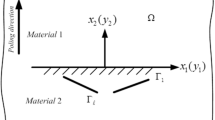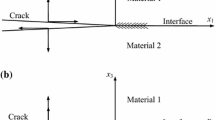Abstract
First, the near-tip stress and electric displacement fields are analytically solved for a dynamically propagating interfacial crack in a piezoelectric bimaterial. Second, from the rate formulation of the energy balance in a piezoelectric material, the path independent dynamic J integral is derived, which has the physical significance of the energy release rate. Using the present near-tip analytical solutions, the relationships between the dynamic J integral and the stress and electric displacement intensity factors are also obtained. It is shown that the path independent dynamic J integral contains the static J integral and the dynamic J integral for elastic materials, and static J integral for piezoelectric materials as special cases. Third, for an interfacial crack in a piezoelectric bimaterial, the path independent separated dynamic J integrals are derived, which have the physical significance of energy flow rates into the propagating interfacial crack tip from the individual material sides or, equivalently, the separated dynamic energy release rates. Fourth, to accurately evaluate mixed-mode stress and electric displacement intensity factors, the component separation method of the dynamic J integral is developed. Finally, the finite element analyses of a static stationary interfacial crack in a piezoelectric bimaterial subject to mechanical, electrical and combined loading are carried out to demonstrate the applicability of the generalized (dynamic) J integral and the separated J integral, and the component separation method.
Similar content being viewed by others
References
Atluri, S.N., Nishioka, T. and Nakagaki, M. (1984). Incremental path-independent integrals in inelastic and dynamic fracture mechanics. Engineering Fracture Mechanics, 20–2, 209–244.
Beom, H.G and Atluri, S.N. (1996). Near-tip fields and intensity factors for interfacial cracks in dissimilar anisotropic piezoelectric media. International Journal of Fracture, 75, 163–183.
Budiansky, B. and Rice, J.R. (1973). Conservation laws and energy release rates. Journal of Applied Mechanics, 40, 201–203.
Cherepanov, G.P. (1979). Mechanics of Brittle Fracture, McGraw-Hill, New York.
Dascalu, C. and Maugin, G.A. (1993). Material forces and energy-release rate in homogeneous elastic bodies with defects, C. R. Acad. Sci. Paris, II-317, 1135–1140.
Dascalu, C. and Maugin, G.A. (1995). Dynamic fracture for piezoelectric material. The Quarterly Journal of Mechanics and Applied Mathematics, 48, 237.
Freund, L.B. (1972). Energy flux into the tip of an extending crack in an elastic solid. Journal of Elasticity, 2, 341–349.
Hwu, C. (1993). Fracture parameters for the orthotropic bimaterial interface cracks. Engineering Fracture Mechanics, 45, 89–97.
Isida, M. (1971). Effect of width and length on stress intensity factors of internally cracked plates under various boundary conditions. International Journal of Fracture Mechanics, 7, 301–316.
Kuna, M. (1998). Finite element analyses of crack problems in piezoelectric structures. Computational Materials Science, 17, 67–80.
Kuo, C.M. and Barnett, D.M. (1991). Stress singularities of interfacial cracks in bonded piezoelectric half-spaces. In J.J. Wu, T.C.T. Ting and D.M. Barnett (eds.) Modern Theory of Anisotropic Elasticity and Applications. SIAM, p. 33.
Maugin, G.A. (1992). Material inhomogeneities in elasticity, Chapter 8. Chapman, London.
Maugin, G.A. (1994). On the J integral and energy-release rates in dynamical fracture. Acta Mechanica, 105, 33–47.
Maugin, G.A. (1995). Material forces: Concepts and applications. Appl. Mech. Rev., 48, 213–245.
Maugin, G.A. and Trimacro, C. (2001). Elements of field theory in inhomogeneous and defective materials, in Configurational Mechanics of Materials, Eds. R. Kienzler and G.A. Maugin, Springer-Verlag, Wien, 55–128.
Moran, B. and Shih, C.F. (1987). Crack tip and associated domain integrals from momentum and energy balance. Engineering Fracture Mechanics, 27, 615–642.
Nikishkov, G.P. and Atluri, S.N. (1987). Calculation of fracture mechanics parameters for an arbitrary threedimensional crack, by the equivalent domain integral. International Journal for Numerical Methods in Engineering, 24, 1801–1821.
Nishioka, T. and Atluri, S.N. (1983). Path-independent integrals, energy release rates and general solutions of near-tip fields in mixed-mode dynamic fracture mechanics. Engineering Fracture Mechanics, 18, 1–22.
Nishioka, T., Hu, Q. and Fujimoto, T. (2002). Component separation method of the dynamic J integral for evaluating mixed-mode stress intensity factors in dynamic interfacial fracture mechanics problems. JSME International Journal, SeriesA, 45, 395–406.
Nishioka, T., Ichikawa, Y. and Maeda, N. (1995). Numerical study on three-dimensional dynamic fracture. In T. Nishioka and J.S. Epstein (eds.) Dynamic Fracture, Failure and Deformation. The American Society of Mechanical Engineers, ASME Publication PVP-Vol. 300, 73–85
Nishioka, T., Murakami, R. and Takemoto, Y. (1990). The use of the dynamic J integral (J') in finite element simulation of mode I and mixed-mode dynamic crack propagation. International Journal of Pressure Vessels and Piping, 44, 329–352.
Nishioka, T. and Shen, S. (2001). ‘Higher order asymptotic solution for an interfacial crack in piezoelectric bimaterial under impact’. Materials of Science Research International, 7, 157–165.
Nishioka, T., Yu, J.H. and Shen, S.P. (2002). ‘Mechanical and technical dynamic J integrals for interfacial dynamic fracture of piezoelectric material’, Proceedings of the 7th Symposium on Impact problems in material, pp. 63–66.
Nishioka, T., Syano, S. and Fujimoto, T. (2003). Concepts of separated J integrals, separated energy release rates and the component separation method of the J integral for interfacial fracture mechanics. Journal of Applied Mechanics Vol. 70, No. 4 (2003), pp. 505–516.
Nishioka, T. and Yasin, A. (1999). The dynamic J integral, separated dynamic J integrals and moving finite element simulations for subsonic, transonic and supersonic interfacial crack propagation. JSME International Journal, Series A, 42, 25–39.
Pak, Y.E. (1990). Crack extension force in a piezoelectric material. Journal of Applied Mechanics, 57, 647–653.
Rice, J.R. (1968). A path independent integral and approximate analysis of strain concentration by notches and cracks. Journal of Applied Mechanics, 35, 379–386.
Shen, S. and Kuang, Z.B. (1998). Interface crack in bi-piezothermoelastic media and the interaction with a point heat source. International Journal of Solids and Structures, 35, 3899–3915.
Shen, S. and Nishioka, T. (2002). Finite element simulation of impact interfacial crack problems in piezoelectric bimaterials. In \(\overset \frown E\)lectromagnetic Mechanics of Solids, edited by G. Maugin and J. Yang, Kluwer Press.
Stroh, A.N. (1958). Dislocation and cracks in anisotropic elasticity. Phil. Mag., 3, 652.
Suo, Z., Kuo, C.M., Barnett, D.M. and Willis, J.R. (1992). Fracture mechanics for piezoelectric ceramics. Journal of the Mechanics and Physics of Solids, 40, 739–765.
Tiersten, H.F. (1969). Linear Piezoelectric Plate Vibrations. Plenum Press, New York.
Yau, J.F. and Wang, S.S. (1984). An analysis of interface cracks between dissimilar isotropic materials using conservation integrals in elasticity. Engineering Fracture Mechanics, 20–3, 423–432.
Wu, K.C. (1991). Explicit crack-tip fields of an extending interface crack in an anisotropic bimaterial. International Journal of Solids and Structures, 27, 455–466.
Author information
Authors and Affiliations
Rights and permissions
About this article
Cite this article
Nishioka, T., Shen, S. & Yu, J. Dynamic J integral, separated dynamic J integral and component separation method for dynamic interfacial cracks in piezoelectric bimaterials. International Journal of Fracture 122, 101–130 (2003). https://doi.org/10.1023/B:FRAC.0000005768.61301.a7
Issue Date:
DOI: https://doi.org/10.1023/B:FRAC.0000005768.61301.a7




